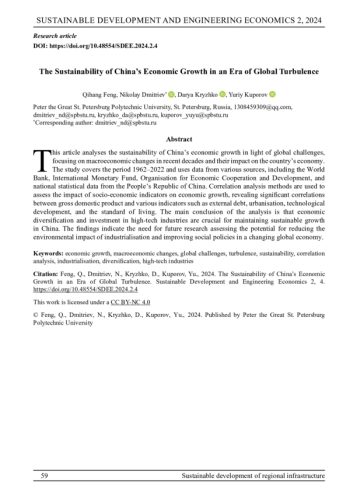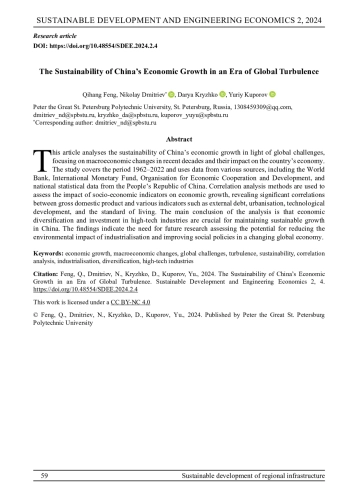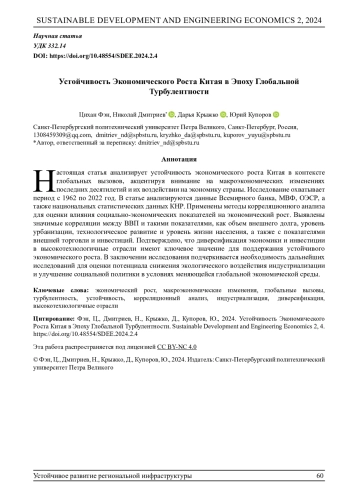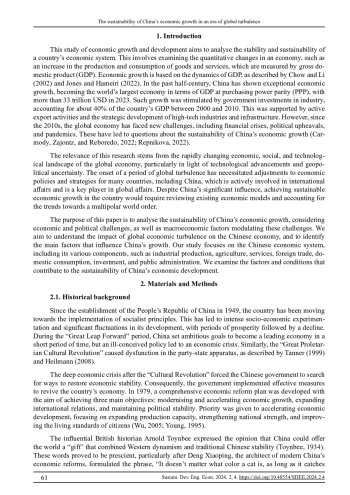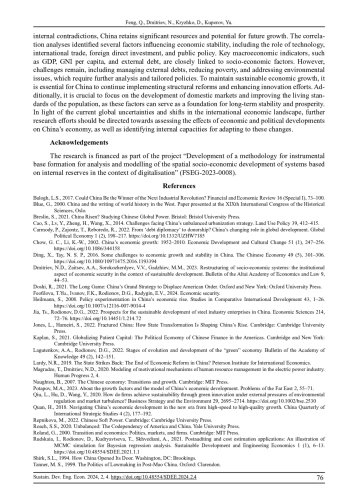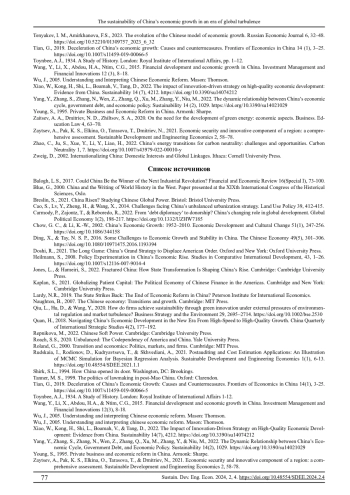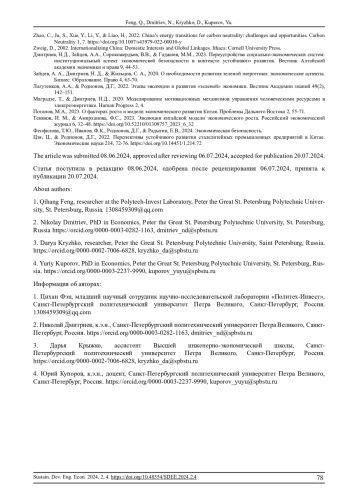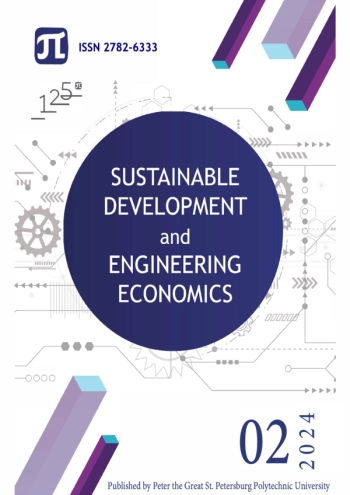1. Balogh, L.S., 2017. Could China Be the Winner of the Next Industrial Revolution? Financial and Economic Review 16(Special I), 73-100.
2. Blue, G., 2000. China and the Writing of World History in the West. Paper presented at the XIXth International Congress of the Historical Sciences, Oslo.
3. Breslin, S., 2021. China Risen? Studying Chinese Global Power. Bristol: Bristol University Press.
4. Cao, S., Lv, Y., Zheng, H., & Wang, X., 2014. Challenges facing China’s unbalanced urbanization strategy. Land Use Policy 39, 412-415.
5. Carmody, P., Zajontz, T., & Reboredo, R., 2022. From ‘debt diplomacy’ to donorship? China’s changing role in global development. Global Political Economy 1(2), 198-217. DOI: 10.1332/UZHW7185 EDN: JGOSPX
6. Chow, G. C., & Li, K.-W., 2002. China’s Economic Growth: 1952-2010. Economic Development and Cultural Change 51(1), 247-256. DOI: 10.1086/344158 EDN: DUUCUH
7. Ding, X., & Tay, N. S. P., 2016. Some Challenges to Economic Growth and Stability in China. The Chinese Economy 49(5), 301-306. DOI: 10.1080/10971475.2016.1193394
8. Doshi, R., 2021. The Long Game: China’s Grand Strategy to Displace American Order. Oxford and New York: Oxford University Press.
9. Heilmann, S., 2008. Policy Experimentation in China’s Economic Rise. Studies in Comparative International Development, 43, 1-26. DOI: 10.1007/s12116-007-9014-4 EDN: FGIYBE
10. Jones, L., & Hameiri, S., 2022. Fractured China: How State Transformation Is Shaping China’s Rise. Cambridge: Cambridge University Press.
11. Kaplan, S., 2021. Globalizing Patient Capital: The Political Economy of Chinese Finance in the Americas. Cambridge and New York: Cambridge University Press.
12. Lardy, N.R., 2019. The State Strikes Back: The End of Economic Reform in China? Peterson Institute for International Economics.
13. Naughton, B., 2007. The Chinese economy: Transitions and growth. Cambridge: MIT Press.
14. Qiu, L., Hu, D., & Wang, Y., 2020. How do firms achieve sustainability through green innovation under external pressures of environmental regulation and market turbulence? Business Strategy and the Environment 29, 2695-2714. DOI: 10.1002/bse.2530 EDN: NSVNVR
15. Quan, H., 2018. Navigating China’s Economic Development in the New Era From High-Speed to High-Quality Growth. China Quarterly of International Strategic Studies 4(2), 177-192.
16. Repnikova, M., 2022. Chinese Soft Power. Cambridge: Cambridge University Press.
17. Roach, S.S., 2020. Unbalanced: The Codependency of America and China. Yale University Press.
18. Roland, G., 2000. Transition and economics: Politics, markets, and firms. Cambridge: MIT Press.
19. Rudskaia, I., Rodionov, D., Kudryavtseva, T., & Skhvediani, A., 2021. Postauditing and Cost Estimation Applications: An Illustration of MCMC Simulation for Bayesian Regression Analysis. Sustainable Development and Engineering Economics 1(1), 6-13. DOI: 10.48554/SDEE.2021.1.1
20. Shirk, S.L., 1994. How China opened its door. Washington, DC: Brookings.
21. Tanner, M. S., 1999. The politics of lawmaking in post-Mao China. Oxford: Clarendon.
22. Tian, G., 2019. Deceleration of China’s Economic Growth: Causes and Countermeasures. Frontiers of Economics in China 14(1), 3-25. DOI: 10.1007/s11459-019-00066-5
23. Toynbee, A.J., 1934. A Study of History. London: Royal Institute of International Affairs 1-12.
24. Wang, Y., Li, X., Abdou, H.A., & Ntim, C.G., 2015. Financial development and economic growth in China. Investment Management and Financial Innovations 12(3), 8-18.
25. Wu, J., 2005. Understanding and interpreting Chinese economic reform. Mason: Thomson.
26. Wu, J., 2005. Understanding and interpreting chinese economic reform. Mason: Thomson.
27. Xiao, W., Kong, H., Shi, L., Boamah, V., & Tang, D., 2022. The Impact of Innovation-Driven Strategy on High-Quality Economic Development: Evidence from China. Sustainability 14(7), 4212. DOI: 10.3390/su14074212 EDN: SIFTRA
28. Yang, Y., Zhang, S., Zhang, N., Wen, Z., Zhang, Q., Xu, M., Zhang, Y., & Niu, M., 2022. The Dynamic Relationship between China’s Economic Cycle, Government Debt, and Economic Policy. Sustainability 14(2), 1029. DOI: 10.3390/su14021029 EDN: LKCHIC
29. Young, S., 1995. Private business and economic reform in China. Armonk: Sharpe.
30. Zaytsev, A., Pak, K. S., Elkina, O., Tarasova, T., & Dmitriev, N., 2021. Economic security and innovative component of a region: a comprehensive assessment. Sustainable Development and Engineering Economics 2, 58-78. EDN: FPZLOG
31. Zhao, C., Ju, S., Xue, Y., Li, Y., & Liao, H., 2022. China’s energy transitions for carbon neutrality: challenges and opportunities. Carbon Neutrality 1, 7. DOI: 10.1007/s43979-022-00010-y EDN: RVJNYB
32. Zweig, D., 2002. Internationalizing China: Domestic Interests and Global Linkages. Ithaca: Cornell University Press.
33. Дмитриев, Н.Д., Зайцев, А.А., Сорокожердьев, В.В., & Гаджиев, М.М., 2023. Переустройство социально-экономических систем: институциональный аспект экономической безопасности в контексте устойчивого развития. Вестник Алтайской академии экономики и права 9, 44-53. EDN: WSFOGF
34. Зайцев, А. А., Дмитриев, Н. Д., & Жильцов, С. А., 2020. О необходимости развития зеленой энергетики: экономические аспекты. Бизнес. Образование. Право 4, 63-70. EDN: QSCQIK
35. Лагутенков, А.А., & Родионов, Д.Г., 2022. Этапы эволюции и развития “зеленой” экономики. Вестник Академии знаний 49(2), 142-151. EDN: FJCJGU
36. Маградзе, Т., & Дмитриев, Н.Д., 2020. Моделирование мотивационных механизмов управления человеческими ресурсами в электроэнергетике. Human Progress 2, 4. EDN: QWZGYT
37. Потапов, М.А., 2023. О факторах роста и модели экономического развития Китая. Проблемы Дальнего Востока 2, 55-71. EDN: HGTDMI
38. Теняков, И. М., & Амирханова, Ф.С., 2023. Эволюция китайской модели экономического роста. Российский экономический журнал 6, 32-48. DOI: 10.52210/01309757_2023_6_32 EDN: EPEPBC
39. Феофилова, Т.Ю., Иванов, Ф.К., Родионов, Д.Г., & Радыгин, Е.В., 2024. Экономическая безопасность. EDN: PBSFRT
40. Цзя, Ц., & Родионов, Д.Г., 2022. Перспективы устойчивого развития сталелитейных промышленных предприятий в Китае. Экономические науки 214, 72-76. DOI: 10.14451/1.214.72 EDN: XZPRQH
